Fatigue in Body Myositis: The Link to Autoimmune Myositis

Fatigue is a common symptom experienced by individuals with autoimmune myositis, a group of rare inflammatory muscle diseases. It manifests as an overwhelming sense of exhaustion that significantly impacts daily functioning and quality of life. One example illustrating the debilitating effects of fatigue in body myositis involves a hypothetical patient named Sarah. As an active young woman who enjoyed participating in sports and social activities, Sarah noticed a gradual decline in her energy levels over several months. Despite getting adequate rest, she found herself constantly fatigued, struggling to perform even simple tasks such as climbing stairs or lifting objects.
The link between fatigue and autoimmune myositis has been recognized but remains poorly understood. Research suggests that multiple factors contribute to the development of fatigue in these individuals, including both physical and psychological aspects. Physiologically, chronic inflammation within the muscles may directly cause weakness and fatigue due to decreased oxygen delivery and impaired muscle function. Additionally, the presence of autoantibodies targeting specific proteins in the muscle cells further exacerbates tissue damage, leading to persistent fatigue. Psychologically, living with a chronic illness can also induce emotional distress and mental exhaustion, which intensifies the experience of fatigue.
Understanding the mechanisms underlying fatigue in body myositis is crucial for improving patients’ overall well-being and developing targeted interventions to manage and alleviate this debilitating symptom. By conducting further research, scientists and healthcare professionals can gain insights into the specific pathways involved in fatigue development, identifying potential therapeutic targets. This knowledge can inform the development of personalized treatment plans that address both the physical and psychological aspects of fatigue in autoimmune myositis patients. Additionally, education and support programs can be implemented to help individuals cope with the emotional toll of living with a chronic illness, reducing mental exhaustion and improving overall quality of life.
Understanding Fatigue in Body Myositis
Fatigue is a common symptom experienced by individuals with body myositis, a chronic autoimmune disease that affects the muscles and causes inflammation. To fully comprehend the impact of fatigue on patients with this condition, it is essential to explore its underlying causes and manifestations. This section aims to provide an overview of the concept of fatigue in body myositis, shedding light on its multidimensional nature.
One example that illustrates the debilitating effects of fatigue in body myositis involves a 45-year-old woman diagnosed with the condition five years ago. Despite receiving treatment and managing her symptoms effectively, she continues to struggle with extreme exhaustion throughout the day. Even after getting plenty of rest at night, she wakes up feeling fatigued and finds herself unable to engage in daily activities without experiencing overwhelming tiredness. This case study exemplifies how fatigue can persist despite attempts at alleviation, underscoring the need for further investigation into its mechanisms.
To better understand the profound impact of fatigue on individuals with body myositis, we must consider several aspects:
- Physical implications: Fatigue not only affects one’s energy levels but also leads to muscle weakness and reduced stamina. Activities that were once easily accomplished become challenging tasks requiring significant effort.
- Emotional toll: Chronic fatigue can take a substantial emotional toll on patients, leading to feelings of frustration, irritability, and even depression or anxiety.
- Social limitations: The persistent exhaustion associated with body myositis often results in social withdrawal as individuals may find themselves unable to participate in events or maintain their usual level of social engagement.
- Impact on quality of life: Fatigue significantly diminishes overall quality of life for those affected by body myositis. It hampers productivity, disrupts relationships, and limits participation in enjoyable activities.
These factors highlight the complexity surrounding fatigue in body myositis and emphasize its far-reaching consequences beyond physical symptoms alone. Understanding the multidimensional nature of fatigue is crucial for healthcare professionals, researchers, and patients alike in order to develop effective management strategies.
In the subsequent section about symptoms and causes of body myositis, we will delve deeper into the various manifestations of this condition and explore its underlying etiology. By gaining a comprehensive understanding of these aspects, we can further comprehend how they contribute to the development and persistence of fatigue in individuals with body myositis.
Symptoms and Causes of Body Myositis
Fatigue is a common symptom experienced by individuals with body myositis, and its impact on daily functioning can be debilitating. To further comprehend the link between fatigue and autoimmune myositis, it is essential to explore the underlying mechanisms that contribute to this phenomenon. This section aims to delve deeper into understanding fatigue in body myositis by examining its symptoms, potential causes, and the implications it has on patients’ quality of life.
To illustrate the challenges faced by those with body myositis-related fatigue, consider the hypothetical case of Sarah. She is a 45-year-old woman diagnosed with dermatomyositis, a specific form of body myositis characterized by muscle weakness and skin inflammation. Despite receiving treatment for her condition, Sarah frequently experiences overwhelming exhaustion, resulting in reduced productivity at work and limited participation in social activities. Her persistent fatigue not only affects her physical well-being but also takes an emotional toll on her overall mental health.
The symptoms associated with fatigue in body myositis may vary from person to person; however, some common manifestations include constant tiredness despite adequate rest, difficulty initiating or sustaining physical activity, cognitive impairment such as memory lapses or reduced concentration levels, and increased sensitivity to exertion. These symptoms significantly impact an individual’s ability to perform daily tasks effectively and have far-reaching consequences on their professional and personal lives.
Several factors contribute to the development of fatigue in body myositis:
- Impaired muscle function: The chronic inflammation present in body myositis leads to progressive muscle damage over time. This muscular impairment directly contributes to feelings of weakness and exhaustion.
- Metabolic dysfunction: Autoimmune processes disrupt normal cellular metabolic pathways within muscles affected by myositis. As a result, energy production becomes inefficient, leading to decreased stamina and increased fatigue.
- Sleep disturbances: Many individuals with body myositis experience sleep problems like insomnia or disrupted sleep patterns. These disturbances can further exacerbate fatigue and contribute to a vicious cycle of exhaustion.
- Psychological factors: Living with a chronic illness like body myositis can result in increased stress, depression, and anxiety. These psychological burdens may amplify the experience of fatigue, making it even more challenging to manage.
The implications of fatigue in body myositis extend beyond physical limitations. Individuals suffering from this symptom often report feeling frustrated, isolated, and hopeless due to their reduced ability to engage in activities they once enjoyed. The emotional toll of constant exhaustion can strain personal relationships and lead to a decreased overall quality of life for these individuals.
In the subsequent section on “The Role of Inflammation in Body Myositis-Related Fatigue,” we will explore how inflammatory processes within the body play a crucial role in perpetuating the debilitating effects of fatigue experienced by those with body myositis. By understanding the underlying mechanisms at work, we can gain insights into potential therapeutic interventions aimed at alleviating this distressing symptom and improving patients’ well-being.
The Role of Inflammation in Body Myositis-Related Fatigue
Fatigue is a common symptom experienced by individuals with body myositis, and its impact on their daily lives cannot be overlooked. One contributing factor to this debilitating fatigue is the role of inflammation in body myositis-related fatigue. Research has shown that inflammation plays a significant role in exacerbating the severity and duration of fatigue episodes in these patients.
To illustrate this point, let us consider a hypothetical case study involving Emma, a 45-year-old woman diagnosed with body myositis. Emma experiences persistent muscle weakness and pain, which often leads to exhaustion after minimal physical activity. Upon examination, elevated levels of inflammatory markers were detected in her blood samples, indicating an ongoing immune response within her muscles.
The link between inflammation and fatigue can be understood through several mechanisms:
- Cytokine release: During an autoimmune response, pro-inflammatory cytokines are released into the bloodstream. These molecules act as chemical messengers that signal and perpetuate the inflammatory process. Unfortunately, they also have direct effects on neural pathways involved in regulating energy levels and sleep-wake cycles.
- Immune-mediated damage: Inflammatory cells infiltrate the affected muscles in body myositis, leading to tissue damage and subsequent repair processes. This continuous cycle of destruction and regeneration places additional metabolic demands on the body, resulting in chronic fatigue.
- Neuroendocrine dysregulation: Inflammation disrupts the delicate balance between various hormones involved in maintaining energy homeostasis. For example, increased levels of cortisol – commonly known as the stress hormone – can contribute to feelings of exhaustion over time.
- Pain perception modulation: Chronic inflammation sensitizes nerve endings within affected muscles, heightening pain perception even during minimal exertion or rest periods. This heightened pain experience further contributes to overall fatigue levels for individuals with body myositis.
- Daily activities such as personal care and household chores become arduous tasks.
- Employment and social engagement may be compromised due to limited energy reserves.
- Mental health can be affected, leading to feelings of frustration, depression, and anxiety.
- Relationships with family members and friends may suffer due to reduced participation in social activities.
In addition to understanding the role of inflammation in body myositis-related fatigue, it is crucial for clinicians to recognize and diagnose this symptom accurately. The subsequent section will delve into the diagnostic approaches used to assess fatigue levels experienced by individuals with body myositis. By identifying and addressing fatigue early on, healthcare providers can improve patients’ quality of life and develop appropriate management strategies.
Please proceed to the next section titled “Diagnosing Fatigue in Body Myositis.”
Diagnosing Fatigue in Body Myositis
The Role of Inflammation in Body Myositis-Related Fatigue has shed light on the connection between inflammation and fatigue experienced by individuals with body myositis. Understanding this link is crucial for diagnosing and managing fatigue effectively. Building on the previous discussion, this section will delve into the diagnostic approaches used to assess fatigue in body myositis.
To illustrate the impact of fatigue in body myositis, let us consider a hypothetical case study involving Sarah, a 45-year-old woman diagnosed with autoimmune myositis. Despite receiving treatment for her muscle weakness and pain, Sarah continues to experience overwhelming exhaustion that significantly impairs her daily functioning. This example highlights how debilitating fatigue can be even when other symptoms are managed.
Diagnosing fatigue in body myositis poses challenges as it involves subjective experiences that vary among individuals. However, healthcare professionals employ various assessment tools to evaluate fatigue severity and its impact on patients’ lives. These assessments may include self-reported questionnaires such as the Multidimensional Fatigue Inventory (MFI) or visual analog scales (VAS). Additionally, objective measures like actigraphy can provide valuable insights into sleep patterns and activity levels.
It is important to recognize that experiencing chronic fatigue goes beyond physical tiredness; it affects multiple aspects of an individual’s life. To convey the immense toll that fatigue takes on those living with body myositis, consider the following bullet points:
- Persistent lack of energy impacts one’s ability to engage in work or social activities.
- Daily tasks become arduous due to reduced stamina and increased effort required.
- Mental fog and difficulties concentrating hinder cognitive function.
- Emotional well-being suffers as frustration and irritability often accompany constant exhaustion.
Furthermore, understanding these emotional implications requires acknowledging both the physical limitations caused by inflammation-related fatigue and their broader effects on mental health. The table below presents a snapshot of some key emotional responses associated with persistent fatigue:
| Emotion | Description | Example |
|---|---|---|
| Frustration | Feeling of annoyance | Struggling to complete simple tasks due to extreme tiredness. |
| Isolation | Sense of being alone or disconnected | Withdrawing from social activities, as physical exhaustion makes participation difficult. |
| Depression | Persistent sadness and loss of interest in daily life | Overwhelming feelings of hopelessness stemming from chronic fatigue. |
In light of the challenges faced by individuals with body myositis-related fatigue, a comprehensive approach is necessary for effective management. The subsequent section will explore various treatment approaches that aim to alleviate fatigue symptoms and improve overall quality of life for those living with this condition.
[Transition sentence]: Understanding the diagnostic process surrounding fatigue in body myositis provides a foundation for exploring Treatment Approaches for Fatigue in Body Myositis without further delay.
Treatment Approaches for Fatigue in Body Myositis
Fatigue is a common symptom experienced by individuals with body myositis, and its impact on daily life can be significant. In order to effectively address fatigue in this population, it is crucial to first understand how it is diagnosed. Diagnosis of fatigue in body myositis involves a comprehensive evaluation that takes into account the patient’s medical history, physical examination findings, and laboratory tests.
To illustrate the diagnostic process, let us consider the case of Sarah, a 45-year-old woman who has been experiencing persistent fatigue and muscle weakness for several months. After reviewing her medical records and conducting a thorough physical examination, Sarah’s healthcare provider orders specific laboratory tests to further investigate her symptoms. These tests may include bloodwork to assess markers of inflammation and muscle damage, electromyography (EMG) to evaluate nerve function, and imaging studies such as magnetic resonance imaging (MRI) or ultrasound to visualize muscle abnormalities.
Once all relevant information has been gathered through these assessments, a diagnosis of fatigue in body myositis can be made based on established criteria outlined by professional medical societies. These criteria typically encompass factors such as the presence of characteristic muscle weaknesses, elevated levels of certain antibodies associated with autoimmune myositis, histopathological evidence from muscle biopsies showing inflammation or degeneration in affected muscles, and exclusion of other potential causes of fatigue.
Understanding the diagnostic process for fatigue in body myositis allows healthcare providers to accurately identify this debilitating symptom and develop appropriate treatment plans tailored to each individual patient’s needs. By recognizing the unique challenges faced by those living with body myositis-related fatigue, we can work towards improving their quality of life through targeted interventions aimed at alleviating symptoms and enhancing overall well-being.
Emotional Bullet Points:
- Living with constant fatigue impacts every aspect of an individual’s life.
- The frustration caused by not knowing the underlying cause of one’s exhaustion.
- The fear and uncertainty associated with a potential diagnosis of body myositis.
- The hope for effective treatment options to regain energy and vitality.
Table: Impact of Fatigue in Body Myositis
| Effects of Fatigue | Physical | Emotional | Social |
|---|---|---|---|
| Decreased ability to perform daily activities | Muscle weakness | Frustration | Isolation |
| Limited participation in work or hobbies | Reduced endurance | Anxiety | Strained relationships |
| Impaired concentration and cognitive function | Chronic pain | Depression | Loss of social connections |
| Increased dependence on others | Sleep disturbances | Feelings of inadequacy | Difficulty maintaining friendships |
In summary, diagnosing fatigue in body myositis requires a comprehensive evaluation that considers the patient’s medical history, physical examination findings, and laboratory tests. By following established criteria, healthcare providers can accurately diagnose this debilitating symptom and develop targeted treatment plans. Recognizing the impact of fatigue on individuals living with body myositis empowers us to provide support and interventions aimed at improving their overall quality of life.
Transitioning into the subsequent section about “Managing Fatigue and Improving Quality of Life in Body Myositis,” it is crucial to explore strategies that address not only the physical symptoms but also the emotional and social consequences arising from fatigue management.
Managing Fatigue and Improving Quality of Life in Body Myositis
It can significantly impact their daily functioning and overall quality of life. Therefore, it becomes crucial to manage fatigue effectively and find ways to improve the well-being of these patients.
To illustrate the challenges faced by those with body myositis, let us consider a hypothetical case study. Emily, a 45-year-old woman diagnosed with autoimmune myositis, experiences severe fatigue that limits her ability to carry out routine activities such as cooking, cleaning, or even taking care of herself independently. Her exhaustion persists despite adequate rest and sleep, leading to frustration and emotional distress.
Managing fatigue requires a multidimensional approach that addresses physical, psychological, and social aspects. Here are some strategies that may help individuals like Emily:
- Exercise: Engaging in regular physical activity tailored to individual capabilities can be beneficial for managing fatigue. Low-impact exercises such as swimming or gentle stretching can help maintain muscle strength while minimizing strain on affected muscles.
- Energy conservation techniques: Learning how to balance activities and prioritize tasks can prevent excessive exertion and conserve energy throughout the day. Breaking down tasks into smaller segments with ample rest intervals can also aid in managing fatigue levels effectively.
- Psychological support: Seeking counseling or joining support groups provides an avenue for individuals with body myositis to express their emotions and gain coping strategies. Addressing mental health concerns related to chronic illness can contribute positively to overall well-being.
- Assistive devices: Utilizing assistive devices such as mobility aids or adaptive equipment ensures independence while reducing physical strain during daily activities.
In addition to adopting these management approaches, healthcare professionals play an essential role in supporting individuals with body myositis through comprehensive care plans. The table below highlights key elements that should be considered when addressing fatigue and improving quality of life in body myositis patients:
| Key Elements | Description |
|---|---|
| Education | Providing information about the condition, treatment options, and self-management strategies. |
| Medication | Prescribing medications that may alleviate fatigue or manage underlying inflammation effectively. |
| Rehabilitation | Referring to physical therapy for tailored exercise programs and occupational therapy for energy conservation techniques. |
| Mental Health Support | Offering counseling services or connecting patients with support groups to address psychological well-being challenges. |
By implementing a holistic approach encompassing these strategies, individuals with body myositis can experience improved management of fatigue symptoms and enhanced overall quality of life.
References:
- Reference 1
- Reference 2





